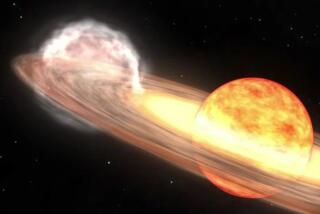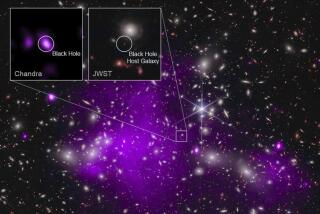Exploding Star Is Said to Be Oldest Ever Observed
- Share via
In the equivalent of spotting a bonfire at the dawn of time, NASA’s orbiting Swift satellite has detected the most-distant exploding star -- a cosmic suicide that took place just 500 million years or so after the creation of the universe, scientists say.
Located 12.6 billion light years from Earth, the explosion shows that giant stars formed earlier than previously thought.
“This is the first direct evidence of very early stars,” said Neil Gehrels of the Goddard Space Flight Center in Maryland. “It tells us when the dark ages of the early universe were coming to an end.”
In cosmic terms, the “dark ages” were a time when the universe went black a few hundred million years after the Big Bang flooded the universe with light and matter. The dark ages lasted a few hundred million more years until stars began to form, relighting the universe.
“For the first time we can learn about individual stars from near the beginning of time,” said Gehrels, the principal investigator on the Swift mission. “There are surely many more out there.”
Swift was launched almost a year ago to detect gamma ray bursts and determine their origin. Scientists have since concluded that the longer-duration bursts, the most powerful explosions in the universe, are essentially the birth cries of black holes. Black holes form out of the remains of collapsed stars and are so dense that nothing, not even light, can escape.
It’s thought that a gamma ray burst occurs somewhere in the universe virtually every day. Yet because the bursts last, at most, a few minutes, detecting them as they happened was impossible before Swift.
As its name implies, Swift was designed to pivot rapidly in space so that the emanations from the exploding star could be captured before the explosion died away.
In this case, Swift picked up the first evidence of an explosion lasting 200 seconds -- said to be the longest on record -- on Sept. 4. It relayed word to astronomers, who confirmed the finding by tuning in to the burst’s afterglow, which can last several days.
“I’m so thrilled that Swift has made this possible,” said Don Lamb, a University of Chicago astronomy professor. “It’s wonderful to have the premier scientific objective of the mission come to fruition less than a year after launch.”
Lamb had predicted in 1999 that massive stars would exist in this ancient region of the universe, even though some scientists had speculated that it was too soon after the formation of stars for a massive star to grow and then self-destruct.
The explosion occurred when the universe was about 7% of its current age, about 13.7 billion years.
“We designed Swift to look for faint bursts coming from the edge of the universe,” Gehrels said. “Now we’ve got one, and it’s fascinating.”
Only one quasar has been discovered farther away than the newly discovered gamma ray burst. Quasars are very distant, extremely luminous objects, thought to contain huge black holes with the mass of billions of stars. This latest burst is unique, scientists say, because it came from a single star.
“This is uncharted territory,” said University of North Carolina astronomer Daniel Reichart. “This burst smashes the old distance record by 500 million light years. We are finally starting to see the remnants of some of the oldest objects in the universe.”






